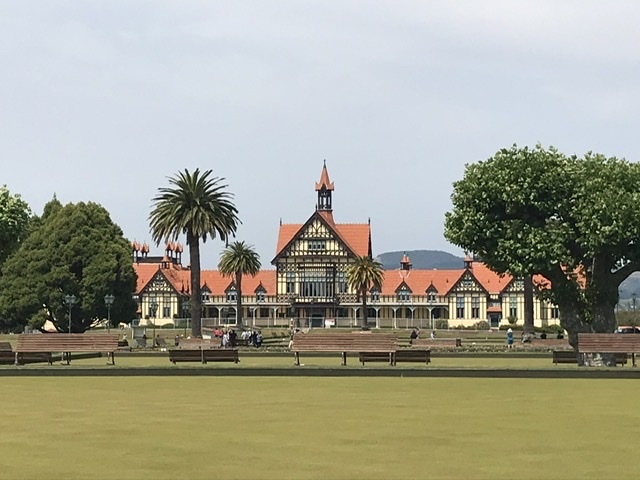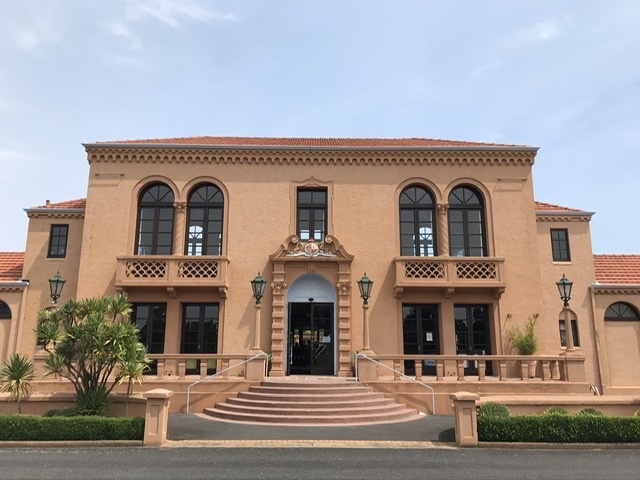
The Tuia Mātauranga Pōkai Whenua GeoTour follows the footsteps of early explorers of Aotearoa New Zealand taking you to places where leaders of the past searched for food, resources and ways to adapt and survive in this new land.
Use the Pōkai Whenua GeoTour as your classroom to explore the stories of the past, in the present, to preserve what is unique in Aotearoa New Zealand for the future.
Collect the codewords to get the Geocoin puzzle piece.
To be able to complete this GeoTour and receive your special Geocoin collectable, remember to take a note of the codeword placed in the cache. This will need to be recorded in your passport which can be downloaded here.
|
"63 of the 150 Pōkai Whenua GeoTour caches will contain a randomly placed special FTF token (a replica of the Tuia Mātauranga GeoTour commemorative coin). This is yours to keep! If you find more than one, you might consider leaving it for the next person who finds the cache."
HISTORY: Part of the site of the Rotorua Government Gardens was known to Māori as Paepaehakumanu and the northern part as Motutara. The area known as Paepaehakumanu was a bird-snaring ground, which led to its name. The area is of historical significance to the local Māori, with battles having been fought here. This historic area was gifted to the British Crown by the original Māori owners of the land, Ngāti Whakaue, in 1880 ‘hei ōranga mo ngā iwi katoa o te ao – for the benefit of the people of the world.’
A CURE IN THE WATERS: The gift included thermal springs which were thought to be beneficial to people’s health. Mineral water was believed to cure arthritis, rheumatism and skin complaints, and improve medical conditions such as gout, impotence, obesity, haemorrhoids, liver disorders and eye problems. Drinking mineral water was sometimes recommended in order to cure insomnia, goitre, and even syphilis.
The New Zealand Government decided to promote Rotorua as a health spa similar to those in Europe such as Baden-Baden. It had recently set up its own tourism department – one of the first in the world – and hoped that a great southern spa at Rotorua would attract wealthy international visitors. But would overseas invalids come all the way to New Zealand for treatments? The added attraction of the impressive volcanic landscape around Rotorua and the opportunity to view Maori culture at places like Whakarewarewa were seen as major drawcards.

THE BATH HOUSE: At the turn of the century, the Government began to develop the complex at the Government Gardens, including the impressive and opulent Bath House. When it was finished in 1908, the Bath House was able to treat a thousand patients a day in its inhalation rooms, mud baths and sun baths. It also offered electric treatments. The Government promoted the Bath House as the place to go for cures for anything from skin disease to brain fag. Patients from the nearby hospital were carried to the thermal baths by wheelbarrow. Some of the more bizarre treatments included a hot air bath which exposed a patient to intense dry heat from electric wires and a water bath which an electric current passed through.

DR ARTHUR WOHLMANN – BALNEOLOGIST: Around this time, the government appointed a balneologist. Dr Arthur Wohlmann combined his knowledge of medicine, chemistry, engineering and landscape gardening, to analyse the mineral content of water from a thermal area and report on its likely medical benefits. He also assessed the tourist potential and development needs of each thermal area. As well as overseeing the development of the Rotorua Bath House, Wohlmann wrote three books about spas and hot springs. Though he was an Englishman, Wohlmann’s German name meant he was a victim of anti-German hysteria during the First World War, so he changed it to Herbert.
Many patients used the Government Garden facilities, including hundreds of returned soldiers, wounded in World War I, but it never attracted the large international tourist market that the Government had hoped for. After World War II, scientific evidence was presented which debunked the supposed curative effects of spas and their popularity waned. In addition, maintenance was extremely costly as the steamy, acidic atmosphere inside the Bath House corroded pipes and caused paint to turn black. The once magnificent Bath House was closed in 1966 and was later converted into the city’s museum.

THE BLUE BATHS: Men and women were segregated at the Bath House. But at the Blue Baths which opened in 1933, people could apparently enjoy movie style glamour, and men and women could get almost naked together in public. This was hugely controversial at the time. These pools were in response to changes in the tourist industry with people wanting more vigorous activities in heated baths, such as swimming and diving.
TODAY: More than a century has passed since the gardens were created, and many features have come and gone, but the quiet charm of the area remains. The Government Gardens precinct is registered by the New Zealand Historic Places Trust as a nationally significant historic area, with important features also registered individually to ensure that the area remains intact for future generations. Rotorua is still a popular tourist destination and has maintained this focus on activity based tourism as well as showcasing its thermal areas and Māori culture.
THE CACHE: The cache is hidden over the fence from Dr Wohlmann's house. Due to tree cover, coordinate readings may differ. Use the following hints if in trouble: The cache is sitting in a tree near the fence line. Please ensure that it is returned securely. The camouflaged film cannister is only large enough for the logbook. Please bring your own pen/cil.